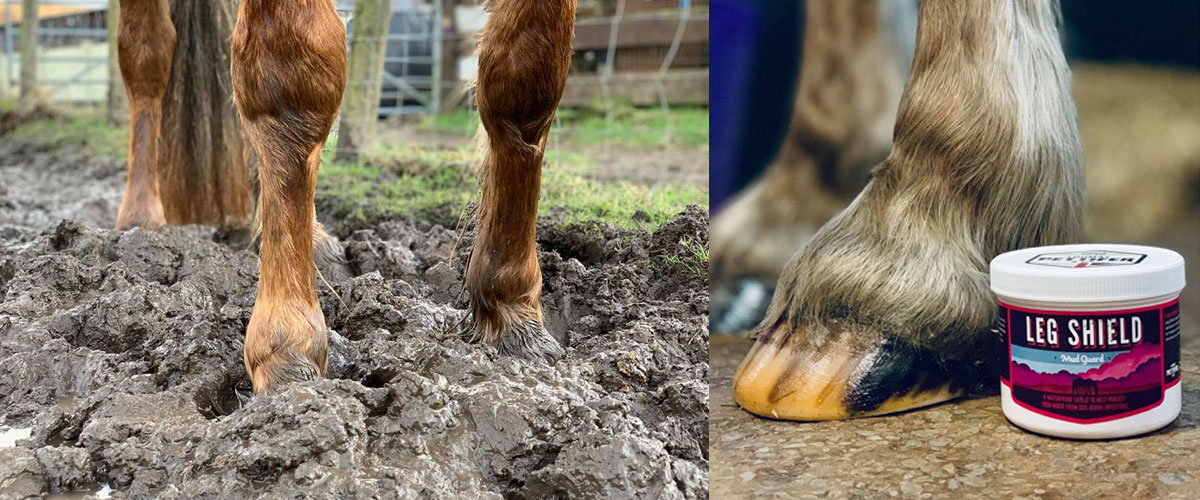Mud, one of our pet hates. Am I right? I don’t think I know anyone who likes mud. My farrier especially hates mud. You can see the pain in his face when you give him a wet, plastered animal that resembles more of a hippo than a horse!
My family hate mud. I come through the doorway into the house with it smeared all over my face, hands and clothes. My friends always point out how glorious it must be to own horses, but if only they knew…
On the other hand, my horse LOVES mud. She loves rolling, standing and splashing around in mud. So, I hate mud but my horse loves mud… great! Unfortunately, my muddy headache is amplified by the fact that mud isn’t all too healthy for horses; it harbours some pretty nasty bacteria which can lead to some painful infections.
As always, prevention is key
Preventing lower limb, mud related infections is so important. After doing a bit of research I found that moisture in the mud can make the skin soft, and then microscopic particles of sand and debris can scratch this softened skin. This can cause small cuts – room for bacteria to enter (I always imagine those little green cartoon monsters from childhood).
Once the bacteria have entered the skin they will multiply, leading to an infection known as mud fever. Mud fever is a very common infection in horses, making prevention even more important. Heel cracks are also very common during cold, wet months. Constant conditions causing the skin to go from wet to dry can lead to cracks forming; this is most common at the heel bulbs.
Muddy Maintenance
Like most fields in winter, the pastures at our yard are very muddy and wet during winter months. They are managed well but the mud is inevitable. Before I started using Thomas Pettifer & Co’s Leg Shield, Gigi would go out and come in plastered in mud, leaving me with few options:
- Hose Gigi down
- Wait for the mud to dry
- Plaster myself in mud trying to work around it
Waiting for the mud to dry is very time consuming. if I want to ride when I bring Gigi in I need to clean her legs. When her legs are covered in mud she cannot wear boots or bandages, this is because they will rub and cause soreness. Riding with wet, muddy legs will also increase the risk of mud fever as sand particles in the ménage can scratch the legs.
Working around the mud can be very frustrating! It gets everywhere! All over my hands, Gigi’s bedding, her grooming kit etc. It is so messy!
This is where Leg Shield comes in…
Why Leg Shield?
The results really speak for themselves. The photograph to the left shows a before and after of Gigi’s legs. When I brought Gigi in I used a damp sponge to remove the excess mud then towel dried her legs. You can also hose your horse’s legs and you’ll notice how easily the mud falls away. The product is smooth and soft; you can feel the silicones in the hair for days after the first application, even after using a damp sponge! I apply Leg Shield every few days, due to its waterproofing properties the formula stays on Gigi’s legs for ages. However, I like to top it up to keep it working at its best!
Everyone asks how Gigi stays so clean. Gigi’s legs have stayed in tip-top condition, with no signs or symptoms of mud fever or cracked heels – making sure we’ve kept on top of our training regime this winter. This photo shows Gigi’s forelegs after ONLY towel drying, after using Leg Shield. Her legs were clean and dry enough for boots to be worn during exercise after just five minutes of coming in from the field!
Not only has Leg Shield become a vital part of my routine for lower limb care during winter, I use it for competitions (especially hunter trials) and hacking. I would also recommend using it when hunting. Not only are her legs pristine for the competition, they’re quick and easy to wipe down for her travel boots!
Not to mention…my farrier LOVES me!
By Hayley Young (customer)

